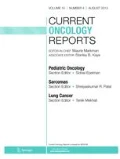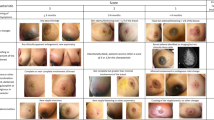Abstract
C-reactive protein (CRP) is a nonspecific but sensitive marker of inflammation. Interleukin-6 (IL-6), IL-1, and tumor necrosis factor á induce the synthesis of CRP in hepatocytes. Increased CRP level is considered to be an important risk factor for atherosclerosis, myocardial infarction, peripheral vascular disease, and ischemic stroke. It is positively correlated with weight loss, anorexiacachexia syndrome, extent of disease, and recurrence in advanced cancer. Its role as a predictor of survival has been shown in multiple myeloma, melanoma, lymphoma, ovarian, renal, pancreatic, and gastrointestinal tumors. Measurement of CRP is simple, cheap, and routine and provides valuable information in palliative care.
Similar content being viewed by others
References
Geissbuhler P, Mermillod B, Rapin CH: Elevated serum vitamin B12 levels associated with CRP as a predictive factor of mortality in palliative care cancer patients: a prospective study over five years. J Pain Symptom Manage 2000, 20:93–103. This interesting study indicates that an elevated serum B12 level is a predictive factor for mortality, independent of CRP and other factors, in palliative care.
Du Clos TW: Function of C-reactive protein. Ann Med 2000, 32:274–278.
Jaye DL, Waites KB: Clinical applications of C-reactive protein in pediatrics. Pediatr Infect Dis J 1997, 16:735–746.
Yeh ET, Anderson HV, Pasceri V, Willerson JT: C-reactive protein: linking inflammation to cardiovascular complications. Circulation 2001, 104:974–975. This is an interesting article discussing the role of inflammation and CRP as predisposing to cardiovascular events.
Gabay C, Kushner I: Acute-phase proteins and other systemic responses to inflammation. N Engl J Med 1999, 340:448–454.
Morrow DA, Ridker PM: C-reactive protein, inflammation, and coronary risk. Med Clin North Am 2000, 84:149–161.
Di Napoli M, Papa F, Bocola V: C-reactive protein in ischemic stroke: an independent prognostic factor. Stroke 2001, 32:917–924.
Kushner I: C-reactive protein elevation can be caused by conditions other than inflammation and may reflect biologic aging. Cleve Clin J Med 2001, 68:535–537. s is an excellent article discussing the role of CRP as a predictor for both biologic aging and poor prognosis in many conditions.
Preston T, Fearon KC, McMillan DC, et al.: Effect of ibuprofen on the acute-phase response and protein metabolism in patients with cancer and weight loss. Br J Surg 1995, 82:229–234.
McMillan DC, Wigmore SJ, Fearon KC, et al.: A prospective randomized study of megestrol acetate and ibuprofen in gastrointestinal cancer patients with weight loss. Br J Cancer 1999, 79:495–500. s is an outstanding study comparing the combination of megestrol acetate and placebo with megestrol acetate and ibuprofen in the treatment of weight loss in patients with gastrointestinal cancer.
Falus A, Meretey K: Histamine: an early messenger in inflammatory and immune reactions. Immunol Today 1992, 13:154–156.
Rasmussen LA, Nielsen HJ, Sorensen S, et al.: Ranitidine reduces postoperative interleukin-6 induced C-reactive protein synthesis. J Am Coll Surg 1995, 181:138–144.
Pelliniemi TT, Irjala K, Mattila K, et al.: Immunoreactive interleukin-6 and acute phase proteins as prognostic factors in multiple myeloma. Finnish Leukemia Group. Blood 1995, 85:765–771.
Tartour E, Dorval T, Mosseri V, et al.: Serum interleukin 6 and C-reactive protein levels correlate with resistance to IL-2 therapy and poor survival in melanoma patients. Br J Cancer 1994, 69:911–913.
Legouffe E, Rodriguez C, Picot MC, et al.: C-reactive protein serum level is a valuable and simple prognostic marker in non Hodgkin’s lymphoma. Leuk Lymphoma 1998, 31:351–357.
Kodama J, Miyagi Y, Seki N, et al.: Serum C-reactive protein as a prognostic factor in patients with epithelial ovarian cancer. Eur J Obstet Gynecol Reprod Biol 1999, 82:107–110. is an interesting study about the role of CRP in predicting survival.
Scambia G, Testa U, Benedetti PP, et al.: Prognostic significance of interleukin 6 serum levels in patients with ovarian cancer. Br J Cancer 1995, 71:354–356.
Ljungberg B, Grankvist K, Rasmuson T: Serum acute phase reactants and prognosis in renal cell carcinoma. Cancer 1995, 76:1435–1439.
Huang A, Tsavellas G: Acute-phase protein, survival and tumour recurrence in patients with colorectal cancer. Br J Surg 2001, 88:1128.
O’Gorman P, McMillan DC, McArdle CS: Prognostic factors in advanced gastrointestinal cancer patients with weight loss. Nutr Cancer 2000, 37:36–40.
Falconer JS, Fearon KC, Ross JA, et al.: Acute-phase protein response and survival duration of patients with pancreatic cancer. Cancer 1995, 75:2077–2082.
Barber MD, Fearon KC, Ross JA: Relationship of serum levels of interleukin-6, soluble interleukin-6 receptor and tumour necrosis factor receptors to the acute-phase protein response in advanced pancreatic cancer. Clin Sci 1999, 96:83–87.
Nozoe T, Matsumata T, Kitamura M, Sugimachi K: Significance of preoperative elevation of serum C-reactive protein as an indicator for prognosis in colorectal cancer. Am J Surg 1998, 176:335–338.
Miyata Y, Koga S, Nishikido M, et al.: Predictive values of acute phase reactants, basic fetoprotein, and immunosuppressive acidic protein for staging and survival in renal cell carcinoma. Urology 2001, 58:161–164.
Vesole DH, Tricot G, Jagannath S, et al.: Autotransplants in multiple myeloma: what have we learned? Blood 1996, 88:838–847.
Bataille R, Boccadoro M, Klein B, et al.: C-reactive protein and beta-2 microglobulin produce a simple and powerful myeloma staging system. Blood 1992, 80:733–737.
Mestries JC, Kruithof EK, Gascon MP, et al.: In vivo modulation of coagulation and fibrinolysis by recombinant glycosylated human interleukin-6 in baboons. Eur Cytokine Netw 1994, 5:275–281.
Cermak J, Key NS, Bach RR, et al.: C-reactive protein induces human peripheral blood monocytes to synthesize tissue factor. Blood 1993, 82:513–520.
Harris TB, Ferrucci L, Tracy RP, et al.: Associations of elevated interleukin-6 and C-reactive protein levels with mortality in the elderly. Am J Med 1999, 106:506–512.
Baeuerle PA, Rupec RA, Pahl HL: Reactive oxygen intermediates as second messengers of a general pathogen response. Pathol Biol 1996, 44:29–35.
Nelson KA, Walsh D, Sheehan FA: The cancer anorexiacachexia syndrome. J Clin Oncol 1994, 12:213–225.
Walsh D, Donnelly S, Rybicki L: The symptoms of advanced cancer: relationship to age, gender, and performance status in 1,000 patients. Support Care Cancer 2000, 8:175–179. s is an excellent comprehensive prospective analysis of symptoms in 1000 patients with advanced cancer.
Strassmann G, Fong M, Kenney JS, Jacob CO: Evidence for the involvement of interleukin 6 in experimental cancer cachexia. J Clin Invest 1992, 89:1681–1684.
Tisdale MJ: Wasting in cancer. J Nutr 1999, 129:243S-246S.
Tempfer C, Zeisler H, Sliutz G, et al.: Serum evaluation of interleukin 6 in ovarian cancer patients. Gynecol Oncol 1997, 66:27–30.
Oka M, Yamamoto K, Takahashi M, et al.: Relationship between serum levels of interleukin 6, various disease parameters and malnutrition in patients with esophageal squamous cell carcinoma. Cancer Res 1996, 56:2776–2780.
Warren RS, Starnes HF Jr, Gabrilove JL, et al.: The acute metabolic effects of tumor necrosis factor administration in humans. Arch Surg 1987, 122:1396–1400.
McMillan DC, Scott HR, Watson WS, et al.: Longitudinal study of body cell mass depletion and the inflammatory response in cancer patients. Nutr Cancer 1998, 31:101–105.
Kato K, Hitsuda Y, Kawasaki Y, et al.: The value of serum C-reactive protein as a survival determinant in patients with advanced non-small-cell lung cancer. Nihon Kokyuki Gakkai Zasshi 2000, 38:575–580.
Wu CW, Wang SR, Chao MF, et al.: Serum interleukin-6 levels reflect disease status of gastric cancer. Am J Gastroenterol 1996, 91:1417–1422.
Nomura K, Noguchi Y, Matsumoto A: Stimulation of decreased lipoprotein lipase activity in the tumor-bearing state by the antihyperlipidemic drug bezafibrate. Surg Today 1996, 26:89–94.
Ohara M, Tsutsumi K, Ohsawa N: Suppression of carcass weight loss in cachexia in rats bearing Leydig cell tumor by the novel compound NO-1886, a lipoprotein lipase activator. Metabolism 1998, 47:101–105.
Tsujimoto S, Kawamura I, Inami M, et al.: Cachexia induction by EL-4 lymphoma in mice and possible involvement of impaired lipoprotein lipase activity. Anticancer Res 2000, 20:3111–3116.
Lavabre-Bertrand T, Exbrayat C, Liautard J, et al.: Detection of membrane and soluble interleukin-6 receptor in lymphoid malignancies. Br J Haematol 1995, 91:871–877.
Yokoyama A, Kohno N, Hirasawa Y, et al.: Evaluation of soluble IL-6 receptor concentration in serum and epithelial lining fluid from patients with interstitial lung diseases. Clin Exp Immunol 1995, 100:325–329.
Baumann H, Gauldie J: The acute phase response. Immunol Today 1994, 15:74–80.
Wigmore SJ, McMahon AJ, Sturgeon CM, Fearon KC: Acutephase protein response, survival and tumour recurrence in patients with colorectal cancer. Br J Surg 2001, 88:255–260. s important study investigates the prognostic significance of a preoperative and postoperative acute phase protein response in relation to disease-specific mortality rate.
Cooper EH, Stone J: Acute phase reactant proteins in cancer. Adv Cancer Res 1979, 30:1–44.
McMillan DC, Wotherspoon HA, Fearon KC, et al.: A prospective study of tumor recurrence and the acute-phase response after apparently curative colorectal cancer surgery. Am J Surg 1995, 170:319–322.
Fujikawa K, Matsui Y, Oka H, et al.: Serum C-reactive protein level and the impact of cytoreductive surgery in patients with metastatic renal cell carcinoma. J Urol 1999, 162:1934–1937.
Earlam S, Glover C, Fordy C, et al.: Relation between tumor size, quality of life, and survival in patients with colorectal liver metastases. J Clin Oncol 1996, 14:171–175.
Goransson J, Jonsson S, Lasson A: Pre-operative plasma levels of C-reactive protein, albumin and various plasma protease inhibitors for the pre-operative assessment of operability and recurrence in cancer surgery. Eur J Surg Oncol 1996, 22:607–617.
Steinshamn S, Brekke OL, Waage A: Soluble tumour necrosis factor receptors, tumour necrosis factor and interleukin-6 in serum in granulocytopenic patients with fever. Br J Haematol 1995, 89:719–724.
Kallio R, Bloigu A, Surcel HM, Syrjala H: C-reactive protein and erythrocyte sedimentation rate in differential diagnosis between infections and neoplastic fever in patients with solid tumours and lymphomas. Support Care Cancer 2001, 9:124–128.
Heney D, Lewis IJ, Evans SW, et al.: Interleukin-6 and its relationship to C-reactive protein and fever in children with febrile neutropenia. J Infect Dis 1992, 165:886–890.
Economos K, Lucci JAIII, Richardson B, et al.: The effect of naproxen on fever in patients with advanced gynecologic malignancies. Gynecol Oncol 1995, 56:250–254.
Ueno H, Okada S, Okusaka T, et al.: Prognostic factors in patients with metastatic pancreatic adenocarcinoma receiving systemic chemotherapy. Oncology 2000, 59:296–301.
Author information
Authors and Affiliations
Rights and permissions
About this article
Cite this article
Mahmoud, F.A., Rivera, N.I. The role of C-reactive protein as a prognostic indicator in advanced cancer. Curr Oncol Rep 4, 250–255 (2002). https://doi.org/10.1007/s11912-002-0023-1
Issue Date:
DOI: https://doi.org/10.1007/s11912-002-0023-1




